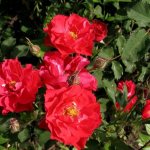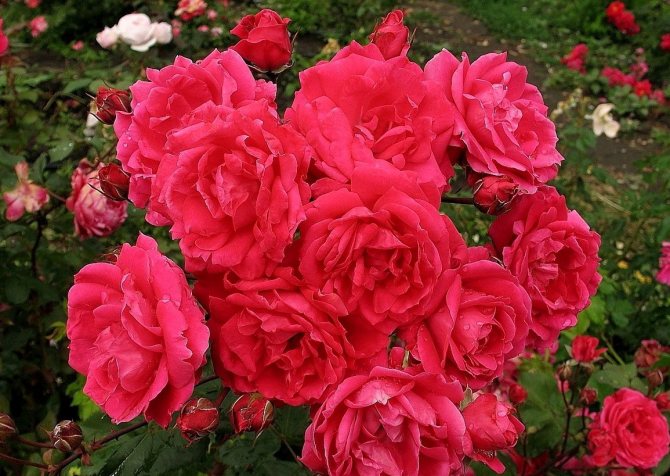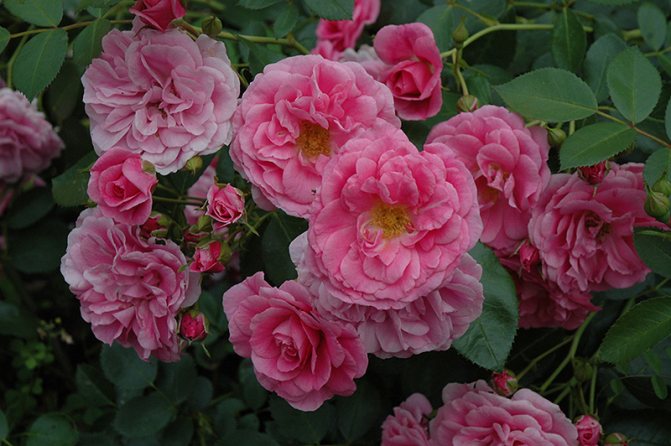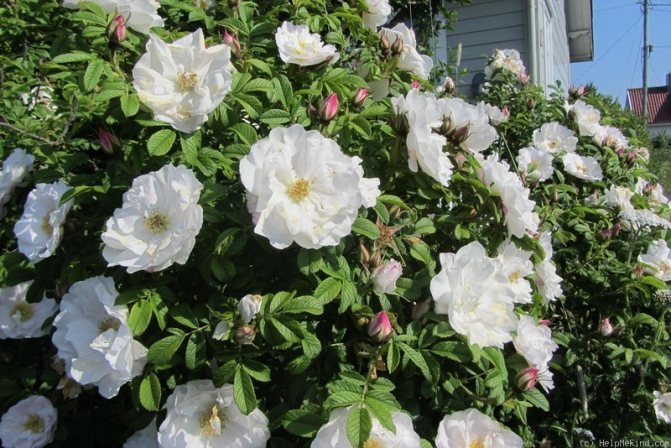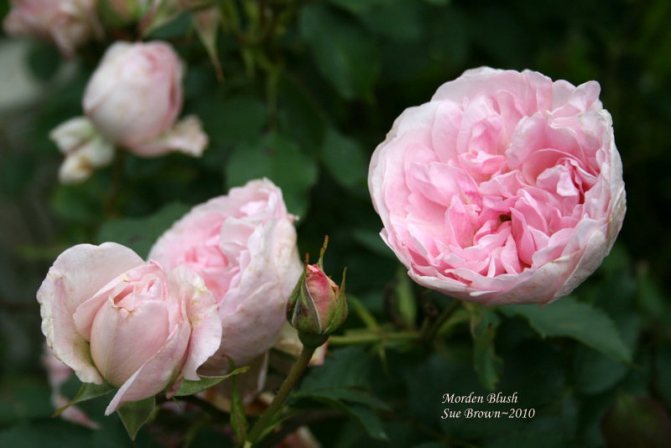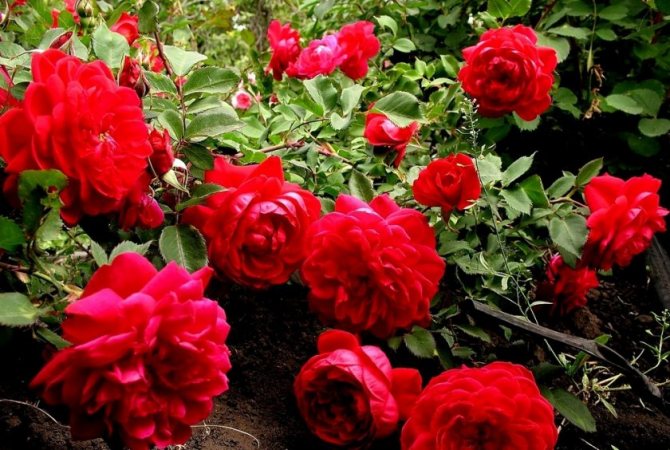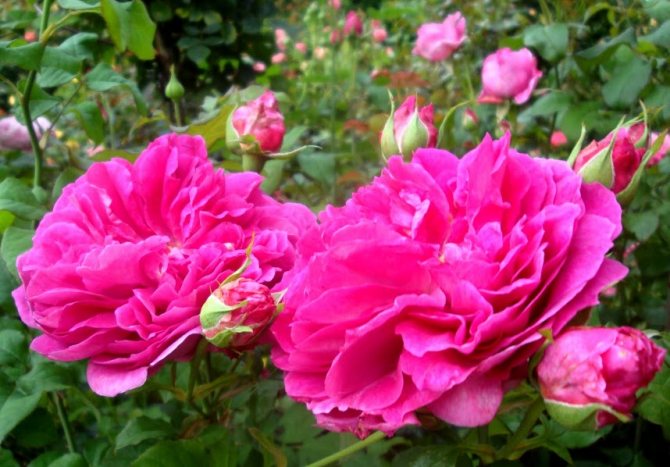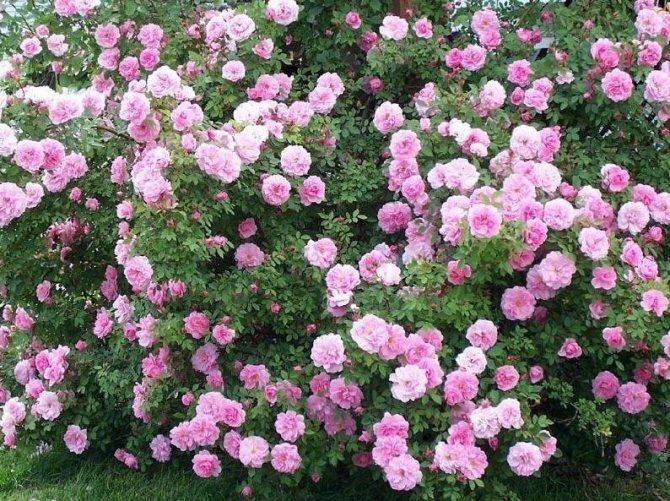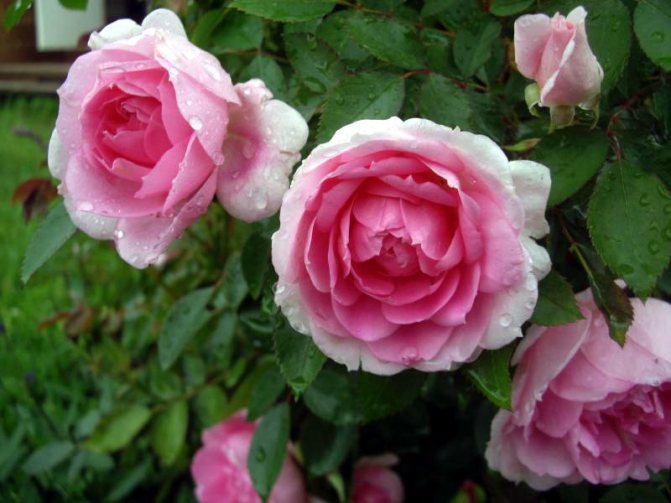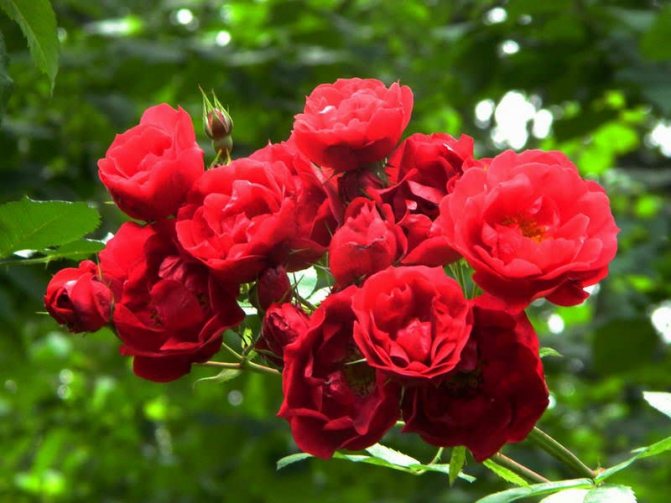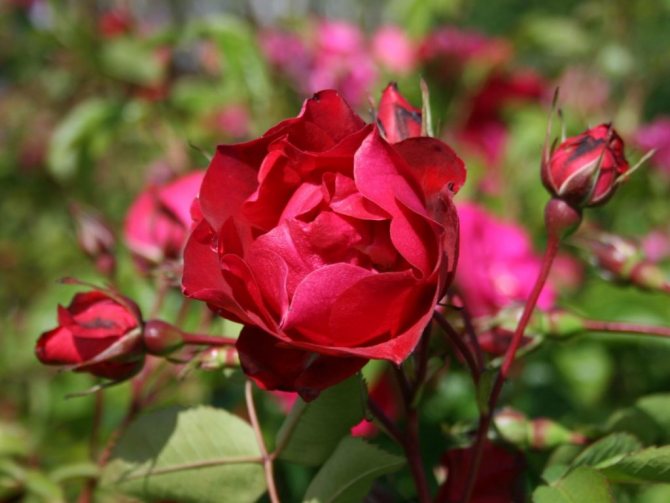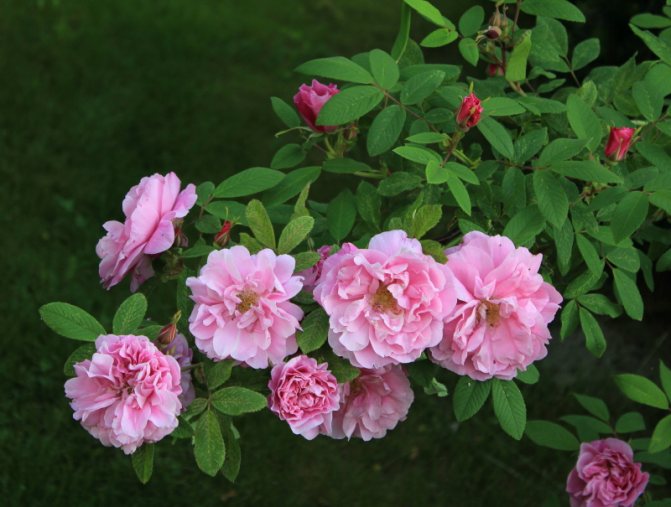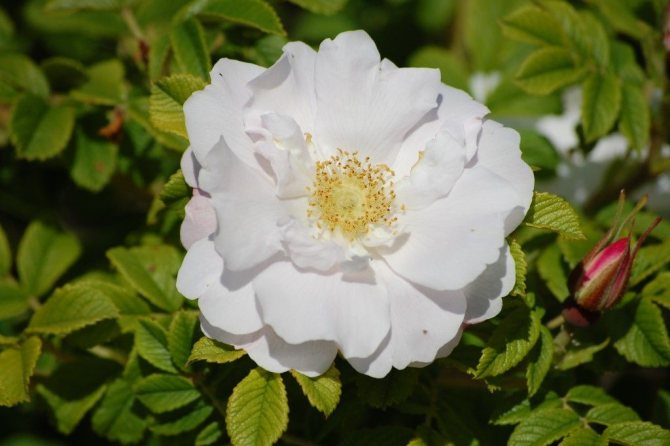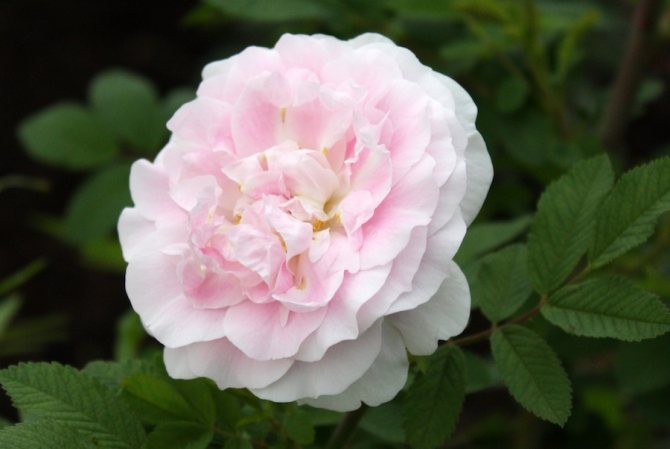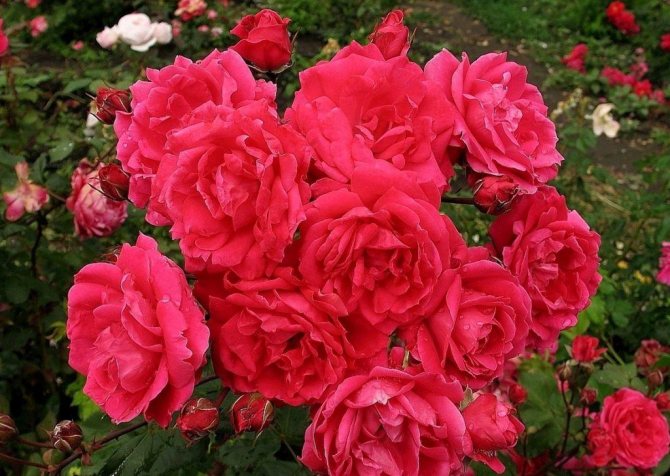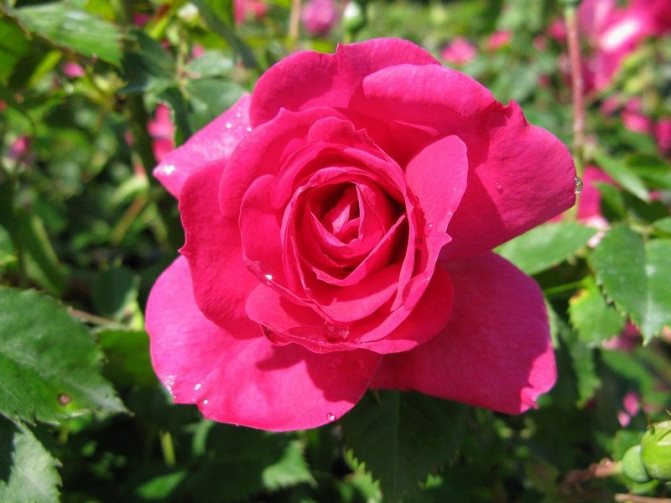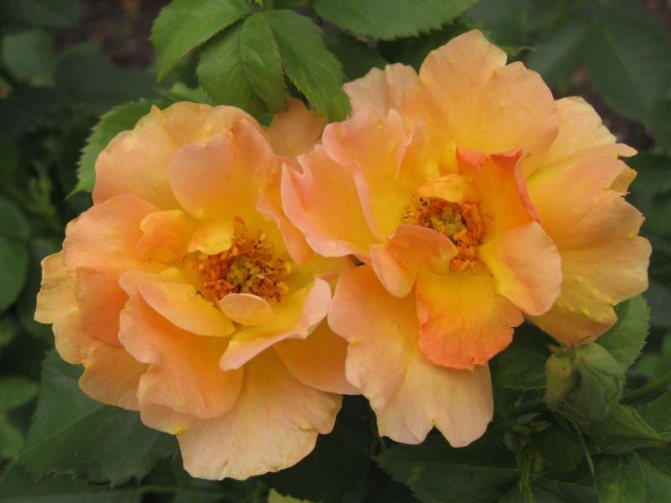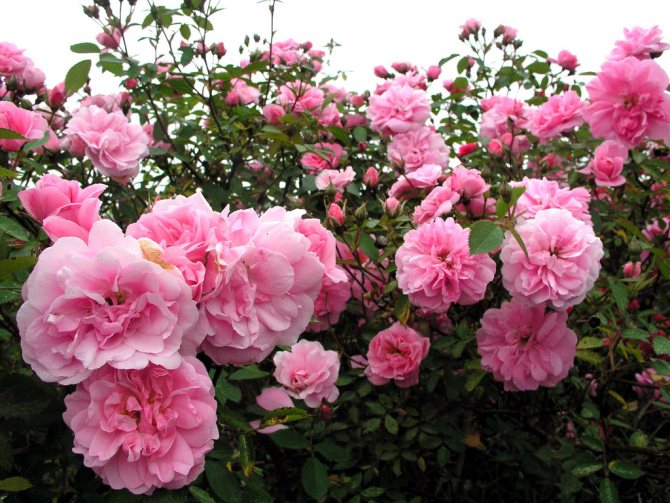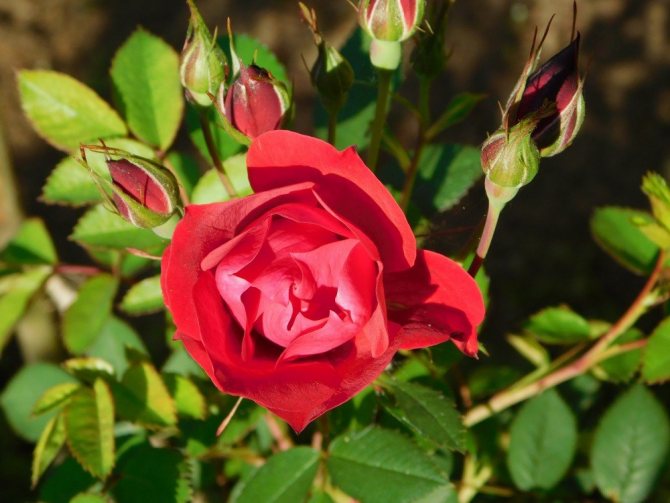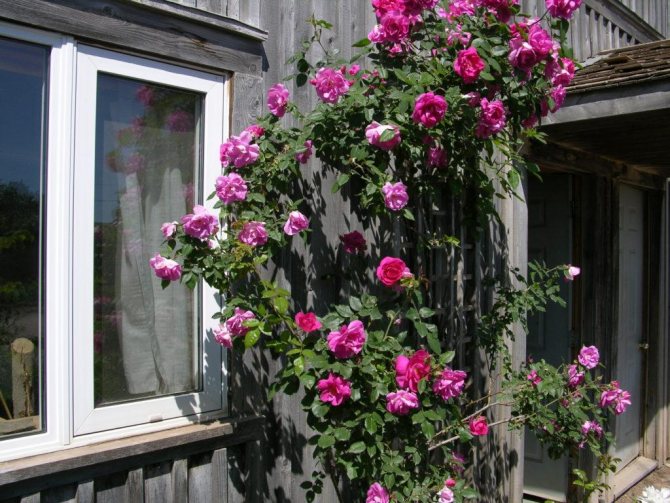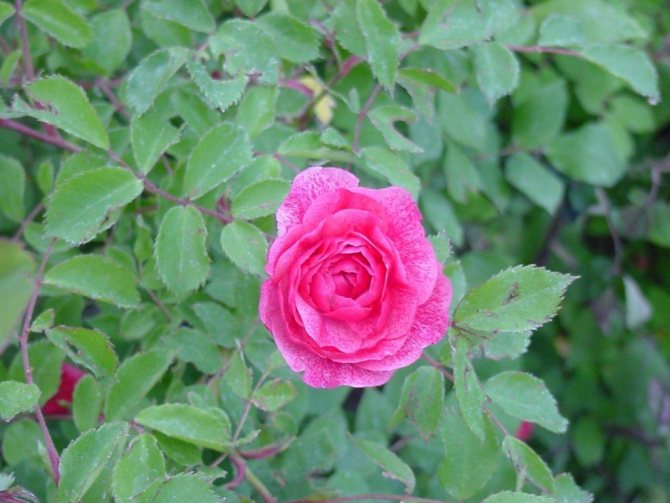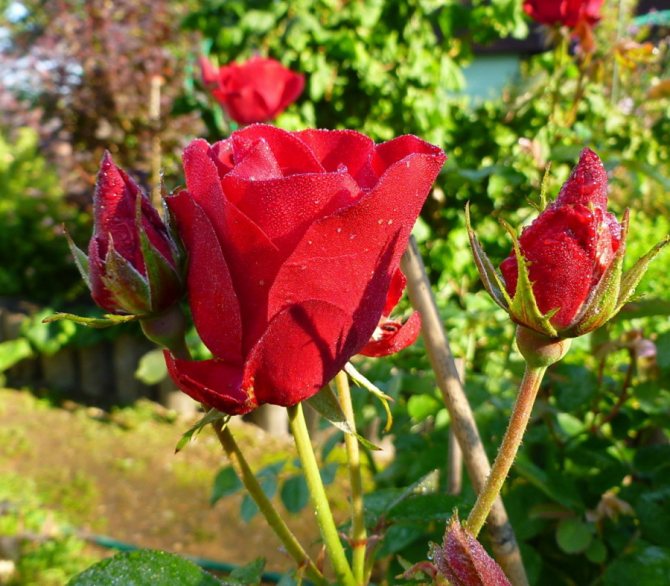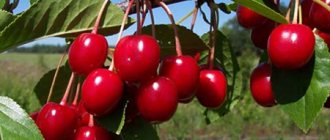Gardeners who do not undertake to grow a regular rose due to difficulties with care can use the Canadian variety. Northern selection was bred specifically for cold climates - it is hardy and unpretentious, blooms in two stages and pleases the eye with bright buds. In the article below, we will name the varieties of Canadian roses, provide a photo and description, and give recommendations for growing.
What are Canadian roses
Most varieties of so-called Canadian roses have passed a special test for survival at temperatures from -30 to -40 ° C and really do not require a special winter shelter - they do not need spruce branches or spunbond. In the conditions of zones 3 and 4, only hilling is needed (it is best to sprinkle with garden soil at the rate of 1 bucket per 1x1 m bush) and snow. Shoots usually freeze out along the line of snow cover, and even if the winter temperature drops below 35 ° C. At the same time, Canadian roses are restored very quickly. This is a distinctive feature of all frost-resistant roses, inherent in the plant genotype.
When choosing a suitable variety, be guided not only by a beautiful photo, but carefully read the description, see the opinion of experienced collectors who really (!) Worked with a particular Canadian, and do not know about her by hearsay.
The pedigree of Canadian roses allows them to be divided into three groups. Depending on the parents, the variety may be less hardy, pay attention to this - some Canadians have a 5th winter hardiness zone.
Features of Canadian breeding
With the financial support of the state, breeders managed to develop frost-resistant varieties of roses that could grow not only in northern Canada, but also in Alaska.
Characteristics of this group of varieties:
- frost-resistant roses can withstand frost of 45 ° C;
- not afraid of temperature changes;
- frozen leaves are easily restored;
- bloom for a long time and magnificently;
- resistant to disease, even with a lack of light;
- beautiful form of shrubs;
- dense, luscious foliage;
- large inflorescences;
- different range of colors.
Wrinkled rose hybrids
Wrinkled rose varieties, including those of Canadian selection, have a very beautiful bush shape. They can be safely used to create borders, hedges, plant in the center of large (more than 5 m in diameter) flower beds or in the background of mixborders. Beautiful foliage even in the lower part of the bush distinguishes them favorably from hybrid tea roses, varieties of the grandiflora and floribunda groups. To achieve continuous flowering, try to continually trim off faded blossoms. Between pruning of inflorescences and flowering in different varieties takes from two to three weeks.
Popular varieties of wrinkled rose
Rose variety Henry Hudson (1976)
Bright compact variety. During flowering, the whole is covered with white-pink flowers with a slight odor. It blooms almost without interruption. Ideal for hedges and group plantings.
Rose Martin Frobisher (1968)
Spreading bush, but erect shoots. In the landscape, it is used to create curtains that set off evergreen hedges of thuja and junipers. Flowering is constant, delicate pink flowers have a very light aroma.
Photo gallery of varieties of Canadian roses >>>
Reproduction
You can propagate the bush by cuttings, after the first flowering. Annual shoots up to 30 cm are separated from the main bush.
In addition to the top two, all other leaves are removed from the shoot, and the cutting itself sits on the prepared area. Future seedlings are buried in the ground at the level of the first leaves and with a slope to the north for uniform illumination.
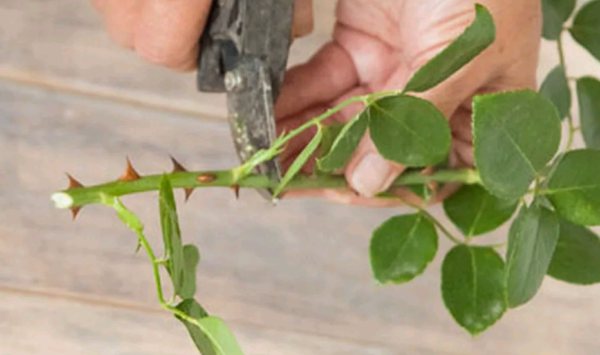
Compost and peat must be added to the ground. Observing the rules of planting frequency, it is necessary to plant cuttings:
- Roses up to 100 cm high - at a distance of 30-40 cm;
- Roses growing up to 150 cm - 40-60 cm;
- Roses growing up to 200 cm - 60 cm between rows.
The easiest and most economical way to create a hedge near the house is by cuttings.
Important! Be sure to cover the shoots with plastic bottles, and then cover the plants with improvised means (hay, grass, shields).
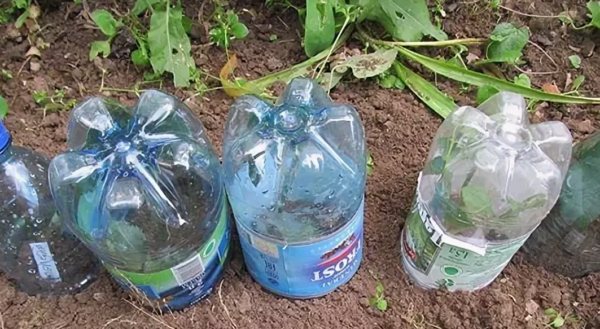

The bushes will take root by the fall. They usually tolerate winter well, but covered with bottles should stand until spring. In the future, it is necessary to mulch the seedlings with crushed tree bark, peat 5-7 cm high, watered with settled water.
For uniform heating of the soil, weeds should be regularly removed around the bushes.
When creating a hedge, the bush can be pruned. This must be done until leaves appear on the shoots. Cut dry branches at the very root of the plant. For longer flowering, constantly cut off dried flowers.
You can diversify your varieties by planting a purchased stalk. Planting a seedling takes place in compliance with all the rules for planting these species. In winter, sprinkle seedlings with earth or peat to a shoot height of up to 20 cm. In the future, the hardened bushes will not need anything.
Climbing canadian roses
Bred, as a rule, with the participation of Cordes rose hybrids. It is necessary to remove old (more than 3 years old) shoots annually in the spring and cover them more thoroughly for the winter. You will need the tightest spunbond. If you do not cut the climbing Canadian roses, you get a sprawling bush with long (up to 2 m) shoots.
Popular varieties of Canadian climbing roses
Rose varieties Quadra (1995)
Flexible shoots reach 1.5–1.8 m, inflorescences of dark red flowers appear throughout the season.
Rose varieties Felix Leclerc Rose (2007)
A climbing rose with shoots reaching 2 and even 3 m. Does not need formative pruning. According to breeders, this variety can withstand temperatures down to –30 ° C.
Rose varieties Champlain (1982)
The variety was created by Canadian breeder Felicitas Svejda. Semi-double flowers are collected in a brush of 5-6 pieces, flowering is abundant and long. In general, the nature of growth is more attributed to roses from the floribunda group, but with a favorable combination of circumstances, you will get a low, up to 130 cm, scrub. This kordesii hybrid is part of the Explorer series developed by Agriculture Canada in Ottawa. Selected for winter hardiness, re-flowering and disease resistance.
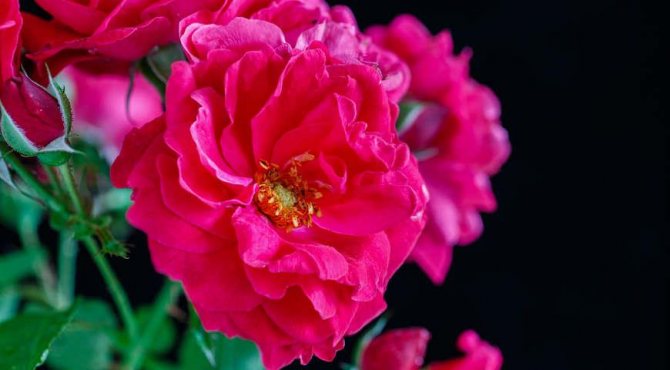

In the photo: Canadian rose varieties Champlain
Rose varieties John Davis (1986)
Also a sort of Svejda selection. The flowers are semi-double, rather large, 7–8 cm in diameter, collected in clusters of 10 pieces. Bush height: 200-250 cm, according to the type of structure of the shoots - rambler. A winter-hardy variety, a hybrid of kordesii in warm years, experienced rose growers grow as a climbing rose. Early flowering, very abundant and long-lasting, repeated - moderate. Prevention of black spot and powdery mildew is necessary.
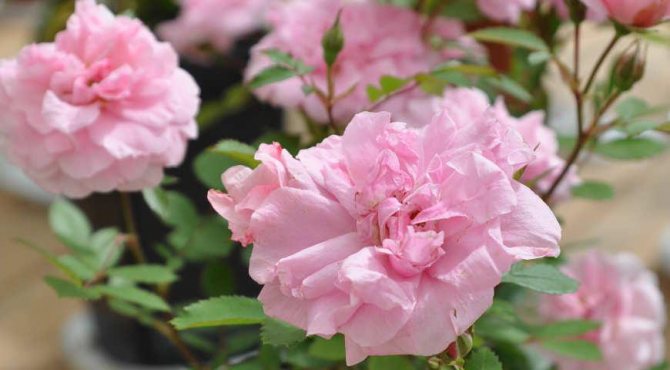

Photo: Canadian rose varieties John Davis
Rose varieties John Franklin (1980)
Another hybrid of the Canadian breeder Svejda. The flowers are medium-sized, semi-double. Flower diameter: 5–6 cm. Bush height: 100–125 cm, so most likely you will get a scrub. A perfect rose for flower beds, background in a mixborder. Because of the large inflorescences, the bush is all in bloom, even if you forget to cut off the faded flowers.
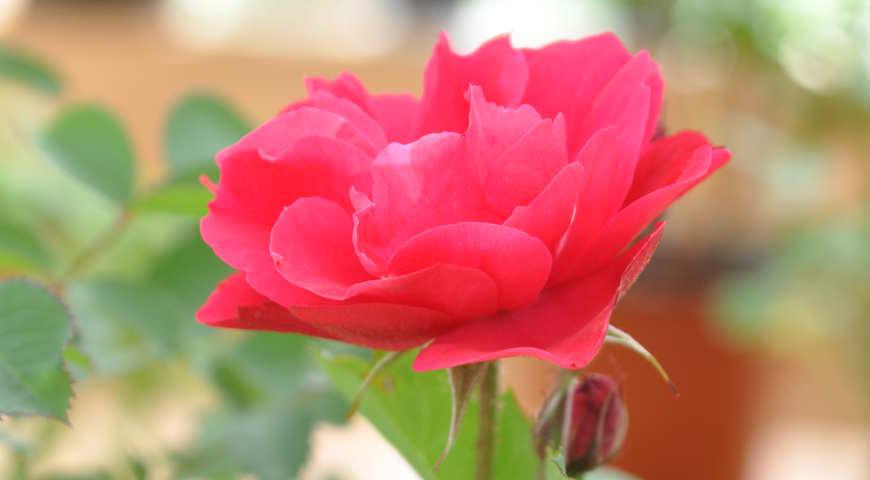

In the photo: Canadian rose fellow John Franklin
Rose varieties John Cabot (1978)
Breeder: Svejda. The flowers are semi-double, 5–6 cm in diameter. The bush is compact, short: 100–125 cm. It can be grown as a scrub or a low climbing rose. It is one of the first kordesii hybrids from the Explorer series roses. The bush is densely leafy, strong and does not require special care except for the prevention of black spot (but this is a property of almost all Cordes roses). It freezes above the snow level, so when used as a climbing rose, it must be removed from the supports and covered.


In the photo: Rose John Cabot
Rose varieties William Baffin (1983)
Breeder: Svejda. Flower type: semi-double, flower diameter: 6-7 cm.Bush height: 180-200 cm, more like a scrub type - erect with slightly drooping shoots. One of the most vigorous roses from the Explorer series. Long-lasting, abundant flowering. Sufficiently resistant to disease.
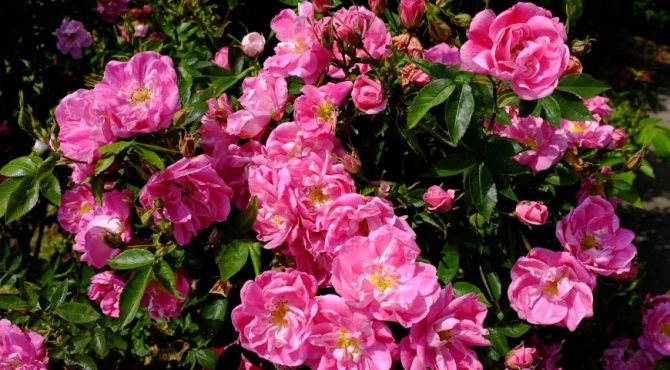

In the photo: Rose William Baffin
Canadian
The best varieties that we have selected after analyzing the review, with photos and descriptions. In this list you will not find any rarities that cannot be found in any nursery, these varieties have proven themselves, and, despite some shortcomings, each of them can become a decoration for your rose garden:
Morden Sunrise is the first yellow rose to be introduced in 1999 from the Parkland series. Differs in high growth and spreading up to 70 cm in width, compact. Buds with 8 petals, 8 cm in circumference. The presence of snow does not require shelter. It is used in landscape design.
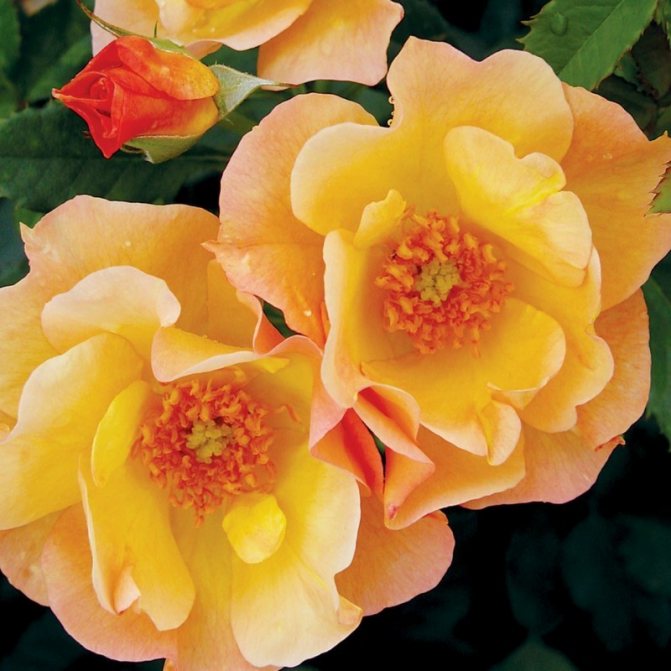

Hope for Humanitu... The breeding of the variety coincided with the centenary of the Red Cross, hence its name. A narrow shrub, upright up to 1.5 m in height, in cold regions - 5 cm. The unblown bud is red; when opened, you can completely see a white spot in the center. Has a light aroma. Loves loamy and humus-rich soil.


Hybrids of specific Canadian roses
Canadian scientists used native species that grow in Alaska. For example, rose arkansana (Rose arkansana). These roses are short, compact and very similar to floribunda or hybrid tea roses. Suitable for urban or cottage landscaping when creating bright spots in mixed flower beds. A group planting of 2-3 bushes of the same variety will look very impressive. Among the modern Canadian roses, there are also modern shrubs, which tend to grow like climbing roses.
Popular varieties of hybrids of specific Canadian roses
Rose of the variety Emily Carr (2007)
Part of the Great Artists series of Canadian roses. Classic crimson flower, reddish young shoots and excellent frost resistance. Blooms continuously throughout the season.
Rose varieties Adelaide Hoodless (1973)
Rose up to 1 m high, bright velvety-burgundy semi-double flowers are collected in huge (up to 30 pieces) inflorescences. It blooms all summer, but especially magnificently at the beginning and end.
Morden Ruby rose (1977)
The bush is no higher than 1 m. The ruby shade makes this rose especially noticeable during the flowering period - at the beginning and at the end of summer.
Morden Cardinette rose (1980)
A low (up to 0.5 m) bush, comparable to miniature roses. Blooms all season.
Rose varieties Marie Victoran (1998)
A tall (up to 1.5 m) rose, all summer long the bush is strewn with classic-shaped pink flowers with a yellow center. Perfect for cutting. The bush is compact, with beautiful glossy foliage.
Prairie Joy rose (1990)
The bush reaches 1.5 m in height, while remaining very elegant. The whole is covered with pink flowers of a classic form from late spring to autumn.
Morden Centennial rose (1980)
Breeder: Marshall. The flowers are semi-double, rather large for this group - 7–8 cm. The height of the bush: 150–175 cm, according to the type of growth of the scrub. Sprawling bush, blooming for a long time. Disease resistant, but prone to black spot. It can freeze slightly in severe winters, pay attention to this feature.
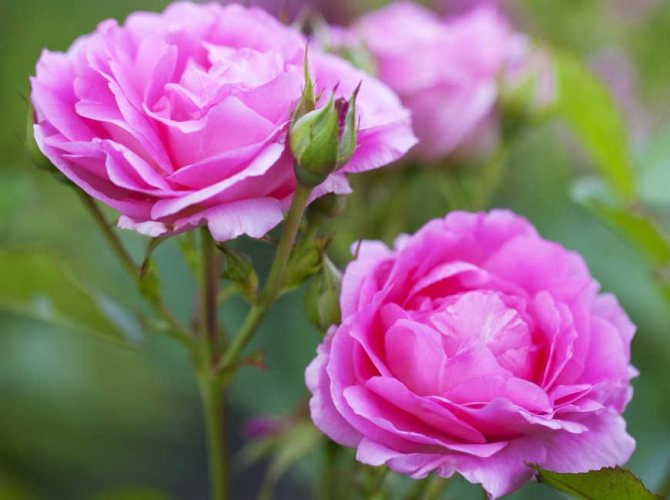

Photo: Canadian Morden Centennial rose
Morden Sunrise rose (1991)
Breeder: Davidson & Collicutt. Flower type: semi-double, flower diameter: 7–8 cm. Bush height: 70–100 cm. Scrub growth type. Winter-hardy yellowish-peach rose of the Parkland series. Long-lasting flowering, high disease resistance.
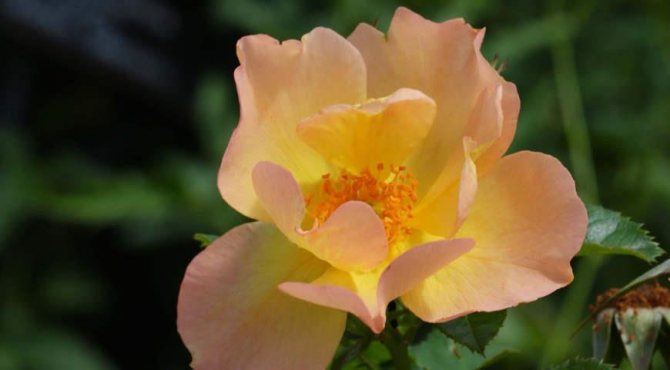

Photo: Canadian Morden Sunrise rose
Hope for Humanity rose (1996)
Breeder: Collicutt & Davidson. Flower type: semi-double, flower diameter: 6-7 cm, collected in reddish inflorescences. Bush height: 75-150 cm. Type: scrub. Named in honor of the centenary of the Canadian Red Cross, part of the Modern Explorer series, bred specifically for the cold winters of Manitoba, although the winter hardiness zone of the 4th variety. Sometimes outbreaks of black spot are possible on the plant.
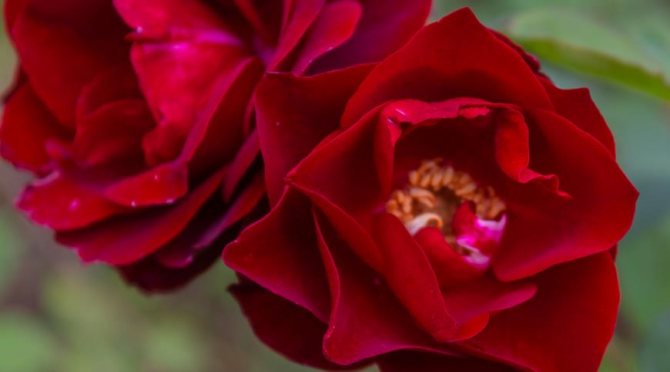

Pictured: Hope for Humanity Canadian rose
Prairie Dawn rose (1959)
Flower type: semi-double. Flower diameter: 7–8 cm. Bush height: 100–150 cm. Type: scrub / climbing. It is part of the Prairie series, practically does not freeze under the conditions of harsh subarctic winters in Minnesota, but the winter hardiness zone is 4. It is prone to black spot, but blooms for a long time.
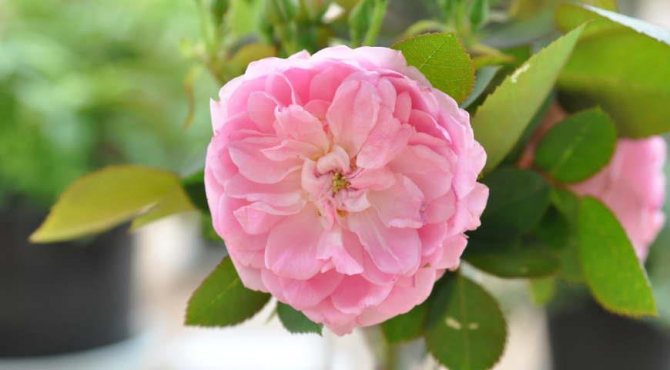

In the photo: Rose Prairie Dawn
Frost-resistant roses of Canadian gardens. The climatic zones of Canada are similar to those of Russia. These roses will be a wonderful decoration for the garden.
Gertrude Jekyll, an English gardener par excellence, devoted to roses with all her heart, hardly imagined how cold a typical Canadian winter can be. Despite this, she appreciated the excellent frost resistance of the rugosa rose hybrids (recall that the word "rugosa" means wrinkled, wrinkled, or ribbed). In her 1902 book Roses for English Gardens, she gives the following advice. "R. rugosa (Rugosa roses, shriveled) have one great quality that sets them apart from others - high frost resistance. This quality allows them to be planted in open areas, where they will be exposed to any atmospheric influences. Many types of roses either do not withstand such conditions and die, or are injured. " Jan Mather, author of The Prairie Rose Gardener, written in 1997, is not so far removed from us in time and closer to home. She lists 28 hybrids, all with frost resistance in zone 2; most of them with repetitive flowering.
Among them is one of my favorite roses, R. Therese Bugnet, grown in Alberta, with deep crimson stems and fragrant pink flowers. Another familiar rose is the "Blanc Double de Coubert", zone 2, a white rose with a strong scent; the late Queen Mother deservedly admired her. Much to my regret, I tried my best to get rid of her (yes, it is), because her growth energy has no boundaries. "Dart's Dash", zone 2, semi-double, purple-red flowers with a pungent smell, more restrained in growth, in the fall; your garden will be decorated with a wonderful ornament - a rose hip with beautiful fruits. The taller Hansa, zone 3, clove scent, delicate magenta petals, and the semi-double Jens Munk, zone 2, with pure pink flowers, both can serve as a good flowering hedge or curb.
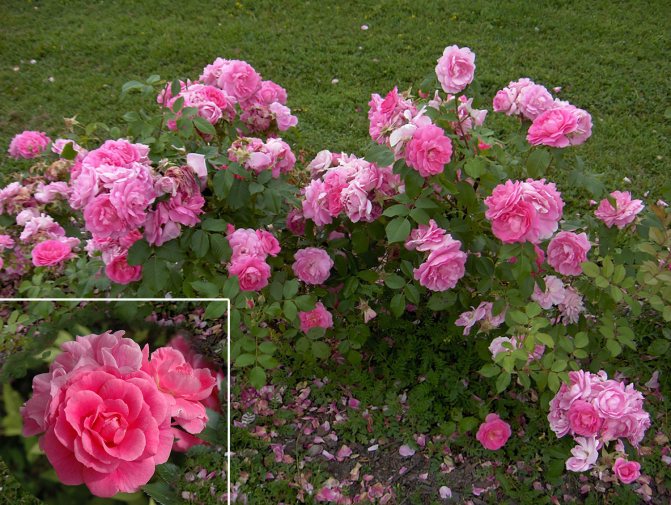

Roses of the Explorer and Parkland series, bred specifically for the Canadian climate, are usually classified as bush roses. Among them is the new "Morden Belle", zone 3, first appeared in 2005, with double pink flowers and shiny leaves. An earlier cultivated variety, and a real beauty in the style of old roses - Morden Blush, zone 2. Terry rose is supremely and equally fragrant. Ivory petals with pink tint, divided into four parts; the rose has a center button. This rose has the longest flowering period among the Park Zone roses; its height is ideal for garden curbs. Another rose, "Cuthbert Grant", zone 2, named for the famous leader, Manitoba's Métis, is similar in size to the previous rose; it has deep red flowers, in the style of hybrid tea roses.
The Iowa-bred Buck roses, all grown in Zone 4, are also common in Canadian gardens, including the pink Carefree Beauty and Applejack, with intense aroma and rose petals with a raspberry tint. The rose with the interesting name "Folksinger" ("Folksinger") has yellow, bowl-shaped flowers, slightly toasted with an apricot hue. "Pearlie Mae", during flowering, gives huge clusters of colorful flowers, which harmoniously combine yellow and pink shades.
How to care for Canadian roses?
Advice from Ksenia Surina, mistress of the rosarium.su rose nursery
- When planting roses of Canadian selection, you need to follow the usual rules: a planting pit up to 70 cm deep, fertile light soil, good lighting, regular watering and mulching.
- Before the shelter, you need to cut out all young shoots - those from which it is difficult to separate the thorns. Due to the non-lignified bark in frosts, they will die and can infect a whole bush. This is what often causes the death of roses. With "Canadians" this happens very rarely, but still there is no need to stress the plant.
- In the spring, before the buds bloom, carry out a sanitary pruning - get rid of the frozen shoots. Weak internal shoots and dry hemp left over from previous pruning are removed. Ugly shoots are cut out and rejuvenating pruning is done, removing old shoots to the base.
- Canadian roses are disease resistant (if the seedlings were healthy). For prevention, it is recommended to collect and burn fallen leaves.
- Some varieties can winter in insulated flowerpots without transplanting into the ground. My know-how: before backfilling the soil, I line the flowerpot with a flexible insulation for "warm" floors (foil polystyrene foam) with a minimum thickness of 3 cm. I usually automate watering, but you can calculate the maximum dosage so that the water does not stagnate in the flowerpot when the drainage hole is almost closed. For the winter, I cut it off shortly, I cover the shoots with earth. From above, like a lid, I cover the flowerpot with a 10 cm thick insulation made of foamed polyurethane, cut to fit the shape of the flowerpot.
- "Canadians" are beautifully cuttings, self-rooted roses are not inferior in size and flowering to grafted ones.
Care
Although the Canadian rose is a fairly easy plant to grow, there are a number of rules that must be followed in order to achieve a stable and rich flowering. This includes top dressing, pruning, and composting the root system for the winter.
At the beginning of spring, cuttings for planting should be chosen about 20-25 cm in size, while they should not have spotting, defects and signs of disease. They can be placed directly in the ground in a permanent place, but do not deepen too much. All leaves are removed except the top pair. Before planting, a small amount of compost is added to the soil (from which the young plant will receive all the necessary trace elements for the growth and formation of new shoots). The distance between them should be at least 1 meter for tall shrubs, which include Canadian park roses, regarding medium - 50x60 cm and low 35-40 cm.After that, they need to be watered and made a shelter from glass jars or plastic containers. The shelter is removed for the next spring, during which time the cuttings have time to take root well.
These beauties feel best in sunny areas. They need to be fed periodically with liquid mixtures of mineral fertilizers, mullein or ash solution. If the summer is too hot, they need watering.
Pruning should be done in early spring, before the first buds appear. Old buds, dried, old branches are subject to removal.
Preventive treatments are rarely required, for the reason that roses of this selection are rarely affected by fungal diseases and parasites.
From amateur gardeners
Some more reviews on varieties. Hope (Nadezhda) - reviews of gardeners about this variety are only positive. It is believed that this variety is just a godsend, as it takes root in any conditions and is not capricious in its care. The only caveat is late flowering compared to other varieties.
A resident from the city of KhMAO-Yurga, grows the following varieties: Moden Blanche, Morden Sunrise, Winniper Park, Hope for Humanity. Their winters are severe, but snowy. Covers bushes with spruce branches and potato tops. Roses winter well for two years.

